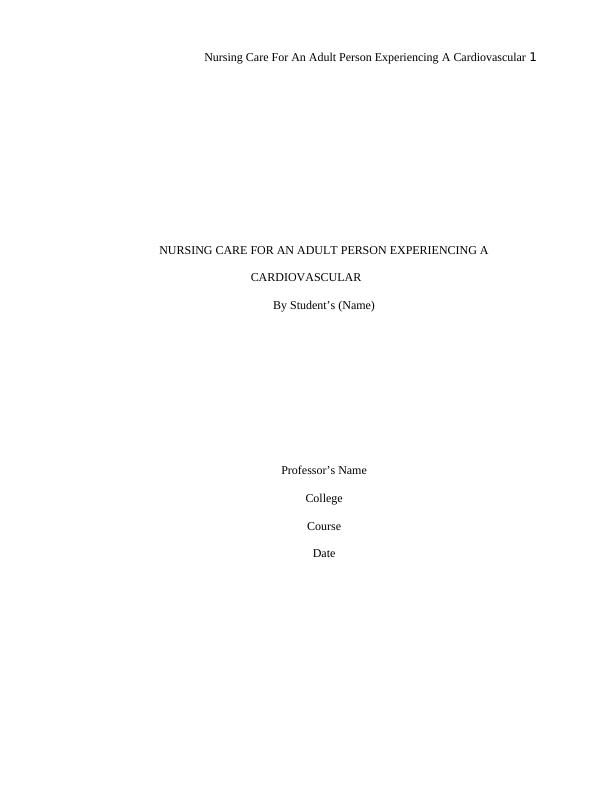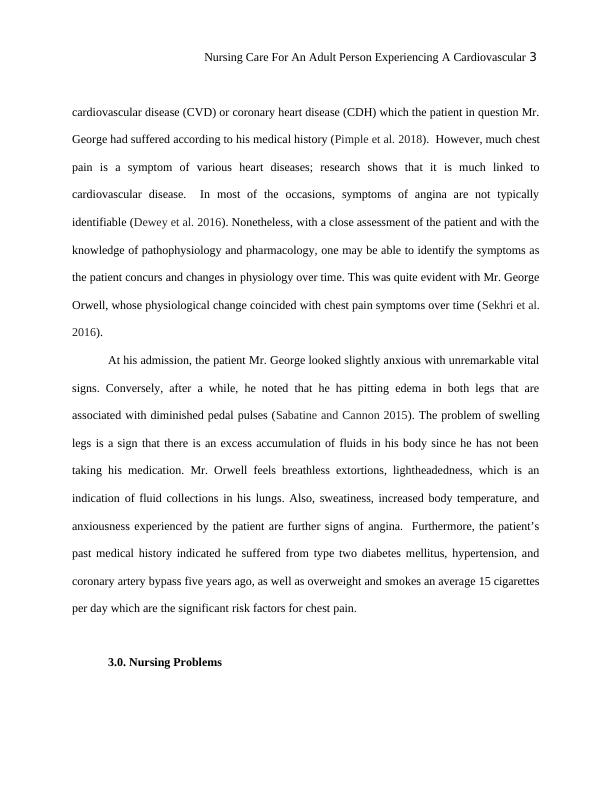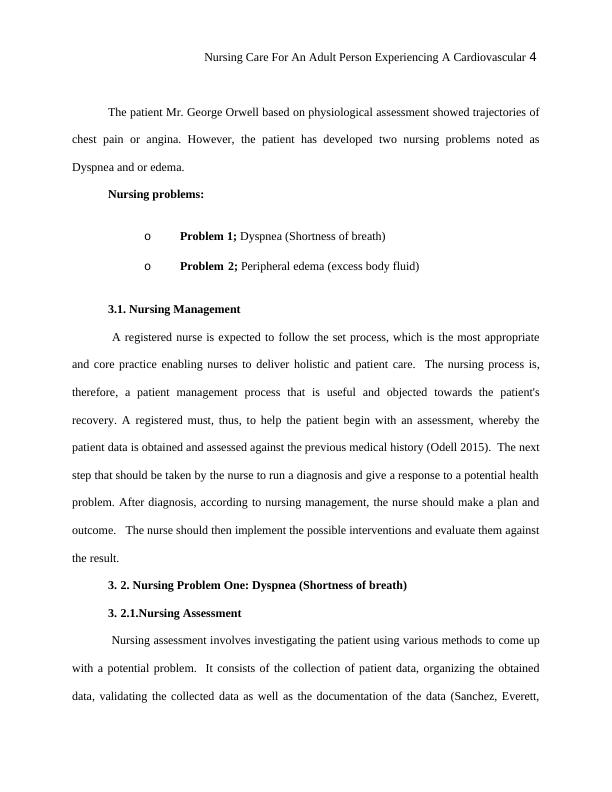Nursing Care For An Adult Person Experiencing A Cardiovascular Assignment 2022
Added on 2022-09-17
12 Pages3293 Words27 Views
Nursing Care For An Adult Person Experiencing A Cardiovascular 1
NURSING CARE FOR AN ADULT PERSON EXPERIENCING A
CARDIOVASCULAR
By Student’s (Name)
Professor’s Name
College
Course
Date
NURSING CARE FOR AN ADULT PERSON EXPERIENCING A
CARDIOVASCULAR
By Student’s (Name)
Professor’s Name
College
Course
Date

Nursing Care For An Adult Person Experiencing A Cardiovascular 2
NURSING CARE FOR AN ADULT PERSON EXPERIENCING A
CARDIOVASCULAR
1.0. Introduction
The content of this paper is an evaluation of a clinical case scenario of Mr.
George Orwell, a 68-year-old patient who has been admitted to the hospital following a chest
pain diagnosis. Even though the patient had been diagnosed with chest pain, his condition
requires more assessments, thus the need for medical history and previous nursing health
records. The content of this paper, therefore, links pathophysiology and pharmacology concepts
to evaluate his case and identifies two major nursing problems related to the scenario. The paper
further provides an assessment, intervention as well as medical management and discharge plan
for the identified nursing problems.
2.0. Primary Admission Diagnosis
The case study patient Mr. George Orwell a 68-year-old, was admitted due to the chest
pains. Chest pain (Angina) is caused by the discomfort in the lungs as a result of the heart not
being able to pump enough oxygenated blood or blood rich in oxygen to the lungs (Paturzo et al.
2016). Further, chest pains ensue due to the inability of the heart muscles to pump enough blood
to the body. The pain may also extend to other parts of the body, and the patient may feel
discomfort in different parts of the body such as arms, legs, shoulders jar and back pain which
was evident at the admission time of Mr. George Orwell (Devlin et al. 2018).
However, chest pain is not a disease but asymptomatic sign of an underlying heart
problem (Urden, Stacy and Lough 2017). In most occasions, angina or chest is a symptom of
NURSING CARE FOR AN ADULT PERSON EXPERIENCING A
CARDIOVASCULAR
1.0. Introduction
The content of this paper is an evaluation of a clinical case scenario of Mr.
George Orwell, a 68-year-old patient who has been admitted to the hospital following a chest
pain diagnosis. Even though the patient had been diagnosed with chest pain, his condition
requires more assessments, thus the need for medical history and previous nursing health
records. The content of this paper, therefore, links pathophysiology and pharmacology concepts
to evaluate his case and identifies two major nursing problems related to the scenario. The paper
further provides an assessment, intervention as well as medical management and discharge plan
for the identified nursing problems.
2.0. Primary Admission Diagnosis
The case study patient Mr. George Orwell a 68-year-old, was admitted due to the chest
pains. Chest pain (Angina) is caused by the discomfort in the lungs as a result of the heart not
being able to pump enough oxygenated blood or blood rich in oxygen to the lungs (Paturzo et al.
2016). Further, chest pains ensue due to the inability of the heart muscles to pump enough blood
to the body. The pain may also extend to other parts of the body, and the patient may feel
discomfort in different parts of the body such as arms, legs, shoulders jar and back pain which
was evident at the admission time of Mr. George Orwell (Devlin et al. 2018).
However, chest pain is not a disease but asymptomatic sign of an underlying heart
problem (Urden, Stacy and Lough 2017). In most occasions, angina or chest is a symptom of

Nursing Care For An Adult Person Experiencing A Cardiovascular 3
cardiovascular disease (CVD) or coronary heart disease (CDH) which the patient in question Mr.
George had suffered according to his medical history (Pimple et al. 2018). However, much chest
pain is a symptom of various heart diseases; research shows that it is much linked to
cardiovascular disease. In most of the occasions, symptoms of angina are not typically
identifiable (Dewey et al. 2016). Nonetheless, with a close assessment of the patient and with the
knowledge of pathophysiology and pharmacology, one may be able to identify the symptoms as
the patient concurs and changes in physiology over time. This was quite evident with Mr. George
Orwell, whose physiological change coincided with chest pain symptoms over time (Sekhri et al.
2016).
At his admission, the patient Mr. George looked slightly anxious with unremarkable vital
signs. Conversely, after a while, he noted that he has pitting edema in both legs that are
associated with diminished pedal pulses (Sabatine and Cannon 2015). The problem of swelling
legs is a sign that there is an excess accumulation of fluids in his body since he has not been
taking his medication. Mr. Orwell feels breathless extortions, lightheadedness, which is an
indication of fluid collections in his lungs. Also, sweatiness, increased body temperature, and
anxiousness experienced by the patient are further signs of angina. Furthermore, the patient’s
past medical history indicated he suffered from type two diabetes mellitus, hypertension, and
coronary artery bypass five years ago, as well as overweight and smokes an average 15 cigarettes
per day which are the significant risk factors for chest pain.
3.0. Nursing Problems
cardiovascular disease (CVD) or coronary heart disease (CDH) which the patient in question Mr.
George had suffered according to his medical history (Pimple et al. 2018). However, much chest
pain is a symptom of various heart diseases; research shows that it is much linked to
cardiovascular disease. In most of the occasions, symptoms of angina are not typically
identifiable (Dewey et al. 2016). Nonetheless, with a close assessment of the patient and with the
knowledge of pathophysiology and pharmacology, one may be able to identify the symptoms as
the patient concurs and changes in physiology over time. This was quite evident with Mr. George
Orwell, whose physiological change coincided with chest pain symptoms over time (Sekhri et al.
2016).
At his admission, the patient Mr. George looked slightly anxious with unremarkable vital
signs. Conversely, after a while, he noted that he has pitting edema in both legs that are
associated with diminished pedal pulses (Sabatine and Cannon 2015). The problem of swelling
legs is a sign that there is an excess accumulation of fluids in his body since he has not been
taking his medication. Mr. Orwell feels breathless extortions, lightheadedness, which is an
indication of fluid collections in his lungs. Also, sweatiness, increased body temperature, and
anxiousness experienced by the patient are further signs of angina. Furthermore, the patient’s
past medical history indicated he suffered from type two diabetes mellitus, hypertension, and
coronary artery bypass five years ago, as well as overweight and smokes an average 15 cigarettes
per day which are the significant risk factors for chest pain.
3.0. Nursing Problems

Nursing Care For An Adult Person Experiencing A Cardiovascular 4
The patient Mr. George Orwell based on physiological assessment showed trajectories of
chest pain or angina. However, the patient has developed two nursing problems noted as
Dyspnea and or edema.
Nursing problems:
o Problem 1; Dyspnea (Shortness of breath)
o Problem 2; Peripheral edema (excess body fluid)
3.1. Nursing Management
A registered nurse is expected to follow the set process, which is the most appropriate
and core practice enabling nurses to deliver holistic and patient care. The nursing process is,
therefore, a patient management process that is useful and objected towards the patient's
recovery. A registered must, thus, to help the patient begin with an assessment, whereby the
patient data is obtained and assessed against the previous medical history (Odell 2015). The next
step that should be taken by the nurse to run a diagnosis and give a response to a potential health
problem. After diagnosis, according to nursing management, the nurse should make a plan and
outcome. The nurse should then implement the possible interventions and evaluate them against
the result.
3. 2. Nursing Problem One: Dyspnea (Shortness of breath)
3. 2.1.Nursing Assessment
Nursing assessment involves investigating the patient using various methods to come up
with a potential problem. It consists of the collection of patient data, organizing the obtained
data, validating the collected data as well as the documentation of the data (Sanchez, Everett,
The patient Mr. George Orwell based on physiological assessment showed trajectories of
chest pain or angina. However, the patient has developed two nursing problems noted as
Dyspnea and or edema.
Nursing problems:
o Problem 1; Dyspnea (Shortness of breath)
o Problem 2; Peripheral edema (excess body fluid)
3.1. Nursing Management
A registered nurse is expected to follow the set process, which is the most appropriate
and core practice enabling nurses to deliver holistic and patient care. The nursing process is,
therefore, a patient management process that is useful and objected towards the patient's
recovery. A registered must, thus, to help the patient begin with an assessment, whereby the
patient data is obtained and assessed against the previous medical history (Odell 2015). The next
step that should be taken by the nurse to run a diagnosis and give a response to a potential health
problem. After diagnosis, according to nursing management, the nurse should make a plan and
outcome. The nurse should then implement the possible interventions and evaluate them against
the result.
3. 2. Nursing Problem One: Dyspnea (Shortness of breath)
3. 2.1.Nursing Assessment
Nursing assessment involves investigating the patient using various methods to come up
with a potential problem. It consists of the collection of patient data, organizing the obtained
data, validating the collected data as well as the documentation of the data (Sanchez, Everett,

End of preview
Want to access all the pages? Upload your documents or become a member.
Related Documents
Nursing Management Case Studylg...
|13
|2991
|86
George Orwell Case Study 2022lg...
|11
|3521
|32
Cardiovascular Diseases: Screening, Diagnosis and Treatmentlg...
|6
|1152
|473
Health of older adults Discussion 2022lg...
|13
|3443
|35
Mr Orwell suffers from hyper cholesterolemialg...
|11
|3366
|56
Nursing Care Plan Assignment- Anthony Khourylg...
|9
|2392
|176